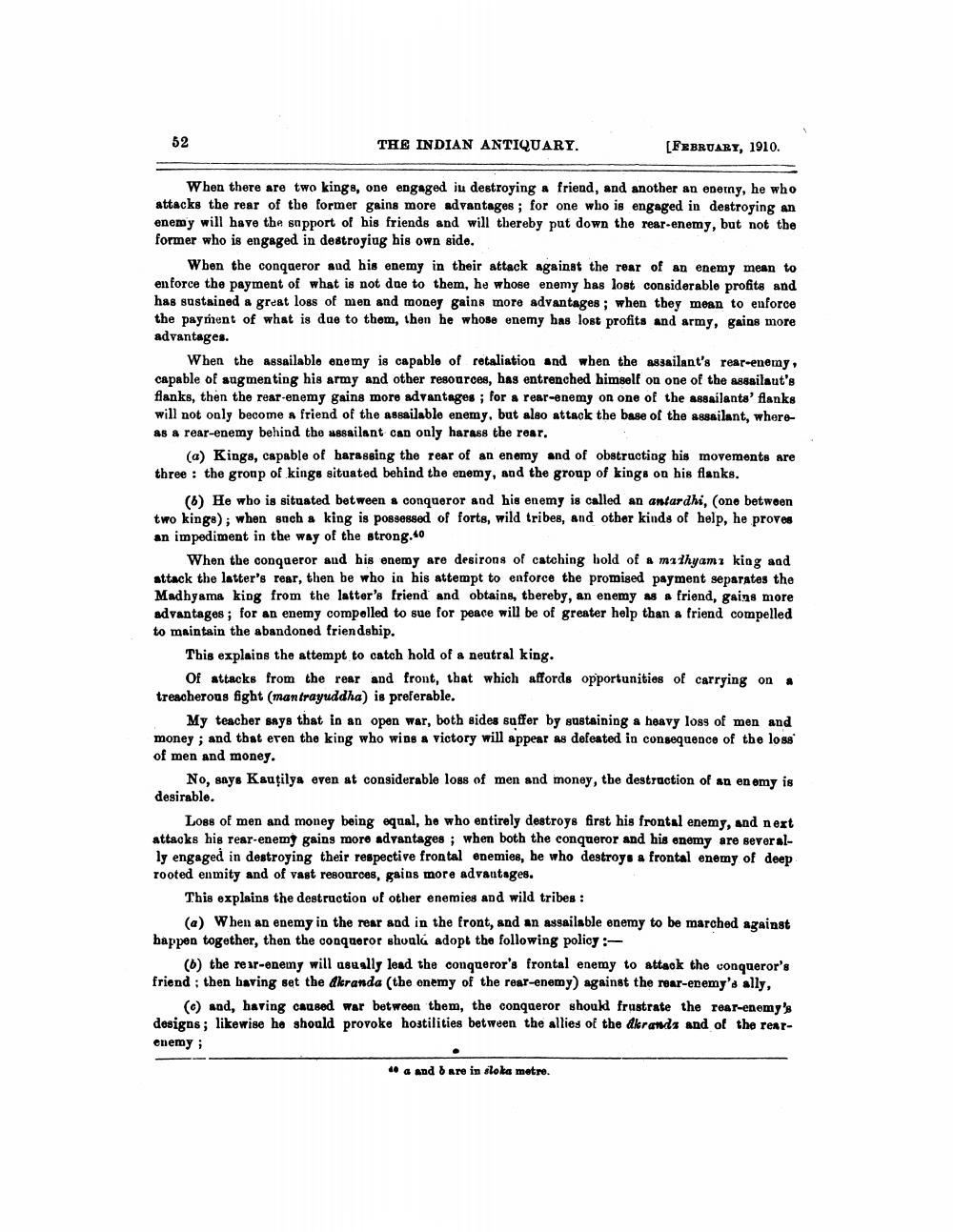________________
52
THE INDIAN ANTIQUARY.
[FEBRUARY, 1910.
When there are two kings, one engaged iu destroying a friend, and another an eperny, he who attacks the rear of the former gains more advantages; for one who is engaged in destroying an enemy will have the sapport of his friends and will thereby put down the rear-enemy, but not the former who is engaged in destroyiug his own side.
When the conqueror and his enemy in their attack against the rear of an enemy mean to en force the payment of what is not due to them, he whose enemy has lost considerable profits and has sustained a great loss of men and money gains more advantages; when they mean to enforce the payment of what is due to them, then he whose enemy has lost profits and army, gains more advantages.
When the assailable enemy is capable of retaliation and when the assailant's rear-enemy, capable of augmenting his army and other resources, has entrenched himself on one of the assailaut's flanks, then the rear-enemy gains more advantages; for a rear-enemy on one of the assailants' flanks will not only become a friend of the assailable enemy, but also attack the base of the assailant, where as a rear-enemy behind the assailant can only harass the rear.
(a) Kings, capable of harassing the rear of an enemy and of obstructing his movements are three : the group of kings situated behind the enemy, and the group of kings on his flanks.
(6) He who is situated between a conqueror and his enemy is called an antardhi, (one betwoen two kings); when such a king is possessed of forts, wild tribes, and other kinds of help, he proves an impediment in the way of the strong.40
When the conqueror and his enemy are desirons of catching bold of a ma thyamı king and attack the latter's rear, then be who in his attempt to enforce the promised payment separates the Madhyama king from the latter's friend and obtains, thereby, an enemy as a friend, gains more advantages; for an enemy compelled to sue for peace will be of greater help than a friend compelled to maintain the abandoned friendship.
This explains the attempt to catch hold of a neutral king.
Of attacks from the rear and front, that which affords opportunities of carrying on. treacherous fight (man trayuddha) is preferable.
My teacher says that in an open war, both sides suffer by sustaining a heavy loss of men and money; and that eren the king who wins a victory will appear as defeated in consequence of the loss of men and money.
No, says Kautilya even at considerable loss of men and money, the destruction of an enemy is desirable.
Loss of men and money being equal, he who entirely destroys first his frontal enemy, and nert attacks his rear-enemy gains more advantages ; when both the conqueror and his enemy are severally engaged in destroying their respective frontal enemies, he who destroys a frontal enemy of deep rooted enmity and of vast resources, gains more advantages.
This explains the destruction of other enemies and wild tribes :
(a) When an enemy in the rear and in the front, and an assailable enemy to be marched against happen together, then the conqueror shoalu adopt the following policy:
(6) the rear-enemy will usually lead the conqueror's frontal enemy to attack the conqueror's friend: then baving set the Akranda (the enemy of the rear-enemy) against the rear-enemy's ally,
(6) and, having caused war between them, the conqueror should frustrate the rear-enemy's designs; likewise he should provoke hostilities between the allies of the dkrands and of the rearenemy;
4. a and I are in sloka metre.




